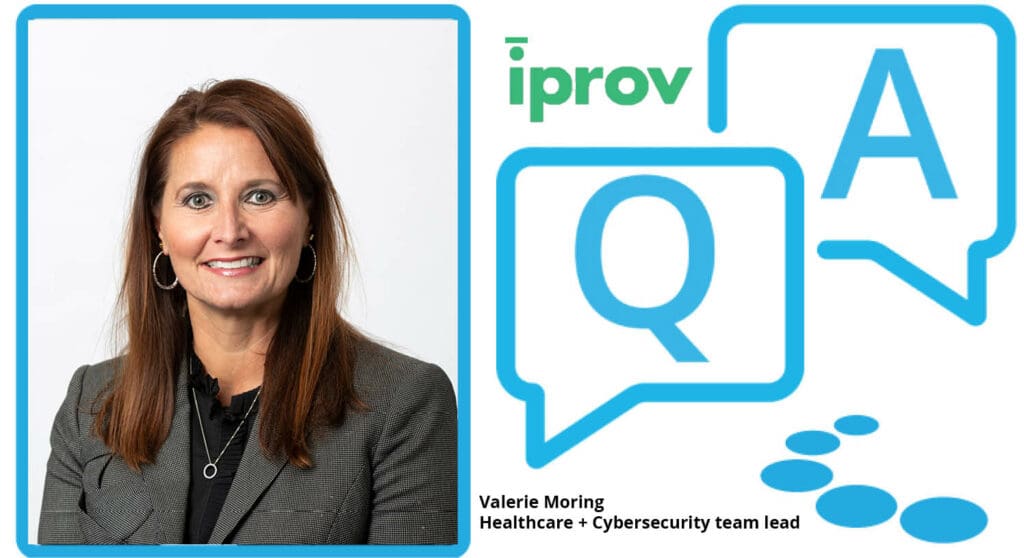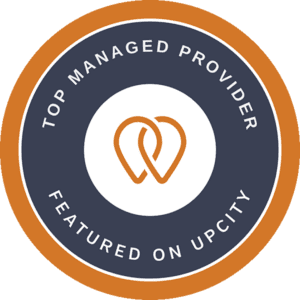Iprov recently interviewed Edafio’s Healthcare and Cybersecurity team lead, Valerie Moring, for their podcast aimed to help build a more profitable healthcare practice.
In this episode, Valerie shares her desire and expertise to help physicians and healthcare organizations provide patient-centered, high-value care that also reduces cost and increases the quality of care or, as Edafio likes to call it “value-based healthcare.” It is the future of healthcare service technology, and it allows for the best sharing of information and managing workflow in the industry. Iprov’s hosts, RJ Martino (RM) and Jordan Smith (JS), help provide clarity to achieving this goal.
Listen to it here: https://iprovonline.com/?powerpress_pinw=5623-podcast
RM: I’m most excited about how Valerie provides a pricing model on what it costs to get started with healthcare consulting and the value it gives clinics and practices. Edafio consultants share a lot about vision, alignment, and strategy. Edafio employs a fantastic group of healthcare consultants, and we are about to go about an inch deep in an area where she could go a mile deep with her knowledge and expertise.
The first thing we like to do is talk about the framework in which we diagnose the problem. We’ve got an eight-step process where the first thing we do is meet with physicians or healthcare leaders and listen to the symptoms of their problems. And some of the symptoms in our world or your world might include taking look into cybersecurity more seriously, which is a symptom,. Or, maybe it’s my people keep talking about weak passwords. Both of these examples are symptoms of a deeper problem.
1. The first step is digging into symptoms and listening to them to understand the underlying issue.
2. The second thing we say is as a healthcare leader; you’ve got to become accountable to fix the problem. We have lots of physicians, especially those who just want to throw money at problems and think that will fix it. And more often than not, it takes them getting involved to fully understanding the issue before it gets resolved.
3. The third thing we do is triage to see if you have a vision of what the future looks like?
4. What does success look like for you?
5. Do you have a corporate culture in your mind?
6. Then we ask, do you have a strategy for achieving that goal? That’s where groups like Edafio often come into the picture to help navigate and build a future a business envision. They help build a strategy and tactics to achieve tangible results because I’m not smart enough to know how to do it. I just see the future.
7. The seventh step is alignment and how we make sure we hold our vendors and even our employees accountable for the strategy and tactics. How do we check progress? How do we make sure we’re meeting timelines, goals, and staying on budget?.
8. And then eighth, finally, we say to engage your team.
That’s our framework on how we think about delivering an excellent healthcare practice result. It starts with an organization like Edafio whenever we talk about technology in building a strategy.
RM: Tell us a little bit about your business. What is your elevator pitch?
VM: Sure, absolutely. I think you have been reading my notes. It’s interesting that you know, like my notes and the different books that I’ve been reading myself personally, align with many things you just said. I was wondering if you’d like maybe tapped into my notes somewhere.
RM: Oh yeah, I hired a group called Edafio. They are experts in hacking.
VM: You hired a certified ethical hacker. That’s great!
VM: Let me share a bit more information about Edafio Technology Partners for those of you guys out there that haven’t heard of us. We’ve been around the Central Arkansas area since 1999. We are based primarily in Little Rock, but we also have offices in Conway and Rogers. Our Mission is to provide business-driven technology solutions that enable our clients to protect and run their business and Our Vision is to be a trusted advisor of technology solutions in our region. We were born out of this need when some local companies and JPMS Cox, a local company here accounting firm could not find an IT company to meet the needs of their business. That is how Edafio Technology Partners was born. We were so successful providing results for JPMS Cox that it quickly developed into a full-service IT provider company. At that time, it was more of a break-fix type of operation, really just maintaining day to day operations of businesses in the area. Now, if you visit our website, you will see that we have a lot of different services from healthcare consulting, cybersecurity practice, and cloud practice.
We exist to help build and protect our client’s businesses through information technology, cloud computing, cybersecurity, and healthcare consulting services.
Valerie Moring
We want to partner and plan for our clients’ future and forecast not only IT but also in cyber, healthcare, and cloud offerings as well. With combined healthcare consulting experience of 50 years among the three of our healthcare consultants, we are well-versed in gathering the right information and data to help save our clients money and build long-term profitable and efficient practices.
JS: Tell us a little bit about your most successful clients. What do they look like before and after a consultation, and how do you help them navigate through their issues?
VM: Some of the things that our most successful clients are doing right now versus those that are not as successful are routine meetings. We see that it’s the same thing on the technology side or the revenue side, where if you don’t engage at the right level, which in this case is the physician level, they handoff different tasks as everyone knows. Most of the time, we are meeting with the office managers or whoever is responsible for particular service offerings that we are working with on them for at that time.
As our clients’ priorities continuously change, given the current environment, we feel it is essential to be adaptive and prepared. For example, today, our clients are focused on telemedicine. Tomorrow, they may need to shift their priorities, like when they get audited by Medicare, Medicaid payer, or private payer.
RM: It’s so important, yet, often, we don’t think about routine and consistency. We talk about this cadence that has to build over time, and the first meeting is fun, and in the second meeting, you start to get the rhythm. By the third meeting, you begin to develop a routine. You talk about the importance of meetings, yet, physicians or leaders think they don’t want meetings. Yet, those meetings are the pulse to the health of a clinic, and without them, they can feel disconnected. The decision-makers often feel like it’s not going well when everybody else is saying it is going great.
VM: Yes, and with our services and our team of healthcare and our cybersecurity consulting arm, we have a very structured approach in how we provide our consulting, and we mandate routine meetings. We take minutes during each meeting and delegate action items and tasks to our teammates along with scheduled follow-up discussions and timelines for completion
We look at quarterly goals and objectives for the business. We reiterate these goals and how we plan to achieve them before our next visit in two weeks and let the client know what tasks they need to complete as well. We take notes and hold ourselves accountable as their trusted advisors. We are a part of their team and that is reassuring to them because they know that we are going to arrive and work alongside them to figure out how to achieve these objectives. Whether we are talking about quality metrics, compliance, policy & procedure pieces as it relates to HIPAA or other regulations that concern these businesses, we aim to provide a lot of value to our clients. The ones that aren’t successful are often frustrated because they don’t know the level of improvements in their revenue or quality measures. These businesses lack strategy and vision as it relates to increased revenue.
With combined healthcare consulting experience of 50 years among the three of our healthcare consultants, we are well-versed in gathering the right information and data to help save our clients money and build long-term profitable and efficient practices.
Valerie Moring
JS: I love that! We talk about alignment all the time. Those metrics you talk about help align the practice’s goal. Ensuring that whenever you arrive for the next meeting, all of you are on the same page and that specific provider and that particular practice also have buy-in from all of their staff.
RM: As you know most of our audience are owners of these practices. The things that likely pique their interest are when you say something like “you are leaving money on the table,” and “revenue is not growing.” Those are like tickler words for any owner who says, yeah, well, tell me about that. Often people think of the cost of technology just as an expense below the item. Talk about how you can help on the revenue side.
JS: Yeah. That’s a great question because we know that we’ve got some listeners out there saying I love the sound of this, but guess what? I’m busy, and I’m still not making money. Are you going to put another meeting on my plate? Talk to that guy.
VM: Yes. I worked in the cardiac catheterization lab, and I have a background in radiologic technology. For 10 ten years now, I’ve been in healthcare IT space and, so that is one of the challenges that I’ve experienced working for non-profits.
Edafio is different because we are passionate, our consultants are eager to help. Our partner practices see the overlap and see the money that they’re leaving on the table based on some of the new value-based care models for all payers.
What we came up with is what’s called Edafio’s Multi-year Quality Strategy Document. Paired with our consulting, we utilize a multi-year quality strategy planning with the document with the right person at the office. It’s a little tedious in the beginning; if anything, it is important to log into those payer portals and pull the information we need to know.
Where are the care gaps that they are not closing? Where are the quality measures? For example, if they’re in the Patient Center Medical Home Model, and they have to report these particular metrics for this program, how are we doing on those? Are we coding our visits, and we are letting our payers understand that this is a huge issue? How sick are our patients? Because right now, patients and physicians understand the importance of coding, and now there are a lot of innovative models to use. But, everyone at the clinic must invest in this team-based care model and understand coding.
Let’s say you have 1000 Medicare patients, 2000 Blue Cross patients, and 1000 Medicaid patients, with the multi-year quality strategy document, we can identify the top three payers. Then we can determine what programs we may not even be participating in and that we haven’t reached out to see how we can add that money back into the practice.
RM: If people have heard of Edafio, you think of it as a technology company, and yet, this seems like so much more than technology. You’ve got a training team, coordination project management, and many experts to help assist along the way.
VM: Right, I’m the team lead of the healthcare and the cybersecurity practice, and we have eight cybersecurity consultants on our team and three healthcare consultants, including myself. It’s interesting because, with compliance and risk, I’ve got one of my healthcare consultants working both sides of that fence. A lot of these things go together if you think about HIPAA compliance and security awareness programs. For instance, as a business owner, you are required to perform annual HIPAA training to cover your business associates. We comprise a dynamic team that educates each other and we have a deep bench of experience and expertise in multiple offerings that are a big concern for businesses.
RM: How involved are the doctors usually in this process? Or if they even thinking about this, is this something they more need to make sure they need to get their practice manager on board? How involved are the doctors in this?
VM: It does depend on the particular client. We’ve got some of our clients where the doctors are very involved. We see some that work with Accountable Care Organizations and work with different Medicare Shared Savings programs or even local ACOs. And then, we see others that just want the office managers to handle it, but come to them with any issues. They are interested in the change, but they don’t want to be at every meeting. So, one of the areas that are one of the services that we offer as far as chart reviews are very beneficial to make sure that again, they’re coding those office visits at the levels that are appropriate, and they have proven documentation. They are not over or under coding because we all know, the electronic medical records will upcode if you’re not careful.
When we do those chart reviews and that particular type of service, the clients have found immediate value, and when you have our consultants do the chart reviews, Lori Brockinton has one-on-one meetings with these providers. Whether it’s a mid-level or an MD, her talking to them and explaining what that looks like and having some teaching and coaching opportunities is valuable.
RM: I think a lot of our listeners hear what you’re saying, and they understand, hey, there’s some money I’m leaving on the table, but in their head maybe, it’s insignificant because I’m only a single provider. They might be able to make me more money or a little bit of money.
JS: I think this is terrific stuff, and I think our audience knows what you’re talking about. Everybody knows, there’s probably some inefficiencies. They probably know that their team might be billing some of this incorrectly and maybe even leaving money on the table. Sometimes you think, you know what, our practice is so small, the dollars saved or dollar earned, it’s insignificant. It’s so easy to minimize that and justify that it is probably not worth the investment.
RM: Do you have an ideal customer? Do you have a type of customer that you enjoy working with, or do you know you provide tons of value?
VM: We do have an ideal customer. We have a couple of ideal customers if you think about it from the broader Edafio perfect client. Edafio as a whole ideal client would be consuming all of our services, and we have a seat at the table as a trusted advisor. But for some of those smaller practices that are only one to two doctors’ practices and, I work with several of those right now, it makes sense to offer a reduced number of hours per month, so it’s affordable for them. When they are ready and receptive to maximizing their revenue opportunity and reducing risk to their organization, we educate them. And again, we gather data to show them some of the new payer models, like here is what Medicaid is offering right now, and here’s what we need to make sure that we are showing the payer the value of healthcare that we’re providing. We know by working with these healthcare providers for all these years that they want to take care of their patients and do what’s best for them.
We’re seeing that payout right now, with everything that there our healthcare heroes are doing to take care of the patients right now. What we want to do is make sure that we provide a valuable contribution by giving them the time to improve their practice. We can do that, no matter the size. We want to meet with some of the Accountable Care Organizations that are prevalent in the state. We think we could maximize their shared savings and particular programs by having more boots on the ground if you will.
It’s a very valuable service, and we do this over and over with different EHRs. We have a lot of different experience between the three of us with various electronic medical records and different practice management systems. We can help them roll those types of programs out quicker so that they can get paid quicker.
JS: Well, there’s not a part of the business that you guys are not integrating with, correct?
VM: Yes, that is correct. Going back to our core values, I didn’t talk about them initially, but they are what I look for when I hire. Anyone that’s going to work on my team, and it’s something I’ve been passionate about since I’ve been in healthcare.
What brought me to work for Edafio were the core values. We’re committed to our clients’ success. When we are working with a client, we are like an employee of their business, and we’re very interested in making them successful because their success is in turn, our success.
Valerie Moring
JS: Yeah, absolutely. I love that. For the listeners out there, if they’re looking at options for some of the stuff that you covered. What questions should they be asking their providers if they’ve already got a group that does this? What are some real-life things, little tidbits of information that you could share to providers if they are thinking about engaging in a type of services like Edafio?
VM: Track KPIs, Key Performance Indicators. For example, we take a clinic’s KPI’s, and we match it to different specialties. I don’t want you to believe that we only work with primary care. I’m just using them as an example, for the record, we work with multi-specialty clinics, and we hone it down to their specialty. That’s another great thing that we do with the collaboration between the healthcare consultants. A lot of people think there’s overlap with Edafio and some of their free sources or the payer sources. So, we plug into those payer sources to make sure that we’re working with the Medicaid, Medicare, or the Blue Cross representative to make sure we’re working together with them to look at all the areas.
- For primary care, examples of KPI’s would be:
- Have you implemented your Medicare wellness visits?
- Have you started doing your wellness visits for all of your payers?
- How are you documenting those?
- How are you making sure that you’re talking to them about advanced care planning?
- Are you billing for advance care planning?
- Have you implemented this care management program?
- Are you billing out for care management?
Many of our clients participate in the merit-based incentive program (MIPS), which used to be called meaningful use. That is where I got started in this whole exciting game of value-based healthcare. Maximizing the use of the electronic medical record and making sure that you have efficiencies within the office is something else we like to look at. If you’re not getting a score of 100 on your MIPS score, we want to discover why. If you were a 70 last year, we want to ensure that we up that to a 100 and get the full maximum positive adjustments two years from now because everything in that particular program is two years behind. What you reported on in 2019, you will see those adjustments two years later.
RM: Wow! So, what you’re doing today does matter. Significant key performance indicators are great things to ask current providers to know if they are if they’ve already got a provider. Edafio’s services are so vast that even if a clinic has an existing provider, they may not offer all of the things you do – whether it’s a great healthcare consultant who doesn’t do the technology implementation or a great technology partner who doesn’t do healthcare consulting. We’re interested as leaders and as business owners not to get married first, Is there like a dating option? Do you guys look at their practice and see if you can help them without charging them anything? What is that process? What’s the first step?
VM: Yes. So, I would say the first step, and this is evolving at Edafio right now because of our great additions to our marketing team and what Melissa Swan is helping us implement. Right now, that would look like a sales team member setting up a time. It would just be a free time that we talk to the practice or talk to the office manager and just ask them a few questions. And then, we come back and have a conversation with the other consultants to discuss how and what we can provide based on the particular business needs based on their answers to our questions. We know you are a urology clinic, so you want to look at those particular measures. Or for orthopedics, you would want to go and look here, and here are some of the, you know, bundled care initiatives that other orthopedics are doing in this region. So just different things we can do like that with an initial sales call but doesn’t feel pitchy. It just feels like a conversation.
Now the future state, we are offering some quick assessments where they complete a form that sends us an immediate response to determine what they need and if we are the right fit for them.
RM: So, good key performance indicators, we talked about a lot of our providers. I know that we’ve also got practice managers and admin staff that are also listening. Maybe they’re looking to this and say man; this will take so much off my plate. I would love to be able to have somebody who has expertise in all these areas, but I have to get buy-in from my C-suite, or I’ve got to get buy-in from my providers. What are some tips that you could give that specific listener to bring this up to their boss?
VM: It would probably take a little bit of time and effort on their part to have a conversation to say here’s where we are at with these payers, here’s what we had last year and this is kind of what we do. Some of the multi-year quality strategy planning that we do take that reflective look, and here’s how we did last year, right. Here’s where we know we need to go, or we don’t know where we need to go, but we know we’re struggling. We know that we can have some conversations with them with just a few pieces of information. How we’re trying to build out this assessment to figure out who their largest payers are. If they’re focused on Medicare and have a lot of Medicare patients, we want to talk about this. How well, did you do in these particular programs? They may see a lot of Medicaid patients, and that may be their biggest payer. We want to make sure we’re doing everything that this payer is asking us to do. From the front-end standpoint and closing care gaps to keep our patients out of the hospitals and send our records to each other electronically. Those things are significant.
JS: I think you mentioned a couple of super important things. For those audience members out there that are listening better in that position, I would say don’t do it alone. Call Valerie and her team and, they’ll help you navigate that conversation if you think that they’d be able to help you out. Right Val?
VM: Yes, yes. We have a few clients where we are on-site a few days a week.
RM: As a business owner, it’s not that there’s nothing to do; it is that there are too many things to do. Trying to prioritize what to do is very hard. You meet with a consultant, and they usually aren’t telling you anything you don’t know. Edafio can identify where to prioritize what. And so if if you’ve got a free assessment, you’ve got an opportunity to let her look at the problems and help prioritize, take advantage of it.
VM: That’s the level of HIPAA training that we provide. We help set up practices for a very affordable amount where there’s an increased security awareness for the business. They can pay off in dividends. On the other side of the fence, our cybersecurity practice gets involved and works on some of our Incident Response services, incident determination, or even help do some consulting in tandem with attorneys and insurance companies. We look at scenarios and breaches that have occurred that are reportable. We can avoid many of these activities, but not all. You don’t ever want to say we’re going to reduce absolutely every risk. After all, that’s not honest and goes against our core value of unquestionable integrity. On the quality side, we can assist those care managers and close care gaps, increase their performance on quality measures, and get paid off as well. Can we quantify that with an exact number today? No, because again, those payers are looking at it with different models.
JS: Valerie is the last question we have for you. If you’re standing in front of a room of new physicians, and they are busier than ever, but they’re not making money. This is not uncommon in the healthcare world these days, and they’re battling through fears, worries, doubt, struggles. What are two or three strategies you would recommend they focus on today that they could take the weekend and then start just to start on the path to success? What are two or three actionable items that you can suggest they start doing to begin to climb out of the hole?
VM: Absolutely. I would say establish clear communication on the vision. Most practices have this, but we like to align it with those larger payers. We’re thinking about the revenue pieces. That shared mission and vision that is tied taking care of patients, putting the patient at the center of the care model, the shared mission and vision approach to for everyone to see that broader vision.
If everybody’s not working together and understanding that, then that can be some issue sometimes within the practices we know and value what your front desk person brings to the table. They’re the first person that your patients are talking to. Valuing just everyone in that office setting and serving each other. That’s so important, and as we serve our patients, we help each other. To me, that would be the recipe for me for the win.
From the financial piece, it would be going back to look and log into those payer portals, know the number of patients, and where they come from.. How many patients do I even have attributed to my practice today because the payers know, and so you need to know, too. You also need to know who are my largest payers. This is what’s paying my bills every day. I need to focus on these top three.
We can fold in others as we go through the multi-year quality strategy planning. But, let’s say, and it may just be only focusing on one. Sometimes, it’s just focusing on one payer because I’m Medicare heavy, I need to focus on this particular payer. Here are the programs they have to offer, and that is going to look different for different practices.
I suggest if you are in an Accountable Care Organization or in any other type of value-based model to look at those contracts and see how they are paying their members. We see some frustration. Now, if they do earn shared savings, how is that trickling down to the providers providing the care?
So, it can be a little tricky. It’s something we like to help practices solve. We have the time to do that, and they want us to do that. Yet, we’re there to partner with them. Some important things are knowing who your top payers are and knowing what patients are attributed to you because whether you’re primary care or a specialty care or even a larger enterprise facility, you’re accountable. Whether you’re also in their models or not, that cost is attributed back to you.
VM: You are welcome. Thank you. You guys have a great day and thank you to all of our healthcare heroes out there taking care of patients right now.
JS: Valerie was awesome. I could spend lunches and lunches with her because she could add so much value. But, I think what I liked the most is when we talked about Edafio and we heard it’s a technology company. We’ve all got this idea that technology below the line is an expense. It’s infrastructure and we spent most of the time not talking about what traditionally you think of as technology, yet, it is technology. What she was talking about is technology and the idea that it can help you build a more profitable healthcare business that is new to our discussions.
Related
How does Technology Affect Patient Care? July 2, 2019In “Blog”
COVID-19 Healthcare | Bounce Back and Recovery May 26, 2020In “Blog”
Top 7 Digital Marketing Trends for 2020: What You Need to Know to Stay Ahead February 11, 2020In “Blog”








